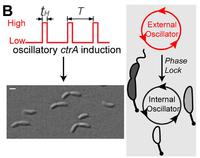 Understanding the functional aspects of cells as autonomous
nonequilibrium processes requires knowing more than just the
molecular players and their partner interactions. Another view is a
"modular cell biology" perspective as proposed by Hopfield et al.
(Nature, 402, 1999). In this talk I will illustrate how rules of
organization of oscillators in regulatory biochemical networks
emerge from measurements at the organismal level; that is, viewing
the 'forest rather than the trees'. This is made possible, in part,
with our development of a large data set microscopy and image
analysis capability for measurement of large numbers of single cells
of the organism Caulobacter crecentus. We are now able to elucidate
fundamental insights about cell growth with high statistical
precision. Our statistical mechanical generalization of an
autocatalytic cycle, based on the deterministic derived in a
deterministic ODE form by Hinshelwood, yields nontrivial predictions
of temperature-dependence of the growth and division time
distributions, a scaling relation of the distributions and a measure
of the nonequilibriumness of cell growth. Extension of the approach
to cell contour analysis and continuum modeling of cell shape during
growth will be discussed. The idea of information flow by way of
pulsed perturbation and response function measurements will also be
presented.
Understanding the functional aspects of cells as autonomous
nonequilibrium processes requires knowing more than just the
molecular players and their partner interactions. Another view is a
"modular cell biology" perspective as proposed by Hopfield et al.
(Nature, 402, 1999). In this talk I will illustrate how rules of
organization of oscillators in regulatory biochemical networks
emerge from measurements at the organismal level; that is, viewing
the 'forest rather than the trees'. This is made possible, in part,
with our development of a large data set microscopy and image
analysis capability for measurement of large numbers of single cells
of the organism Caulobacter crecentus. We are now able to elucidate
fundamental insights about cell growth with high statistical
precision. Our statistical mechanical generalization of an
autocatalytic cycle, based on the deterministic derived in a
deterministic ODE form by Hinshelwood, yields nontrivial predictions
of temperature-dependence of the growth and division time
distributions, a scaling relation of the distributions and a measure
of the nonequilibriumness of cell growth. Extension of the approach
to cell contour analysis and continuum modeling of cell shape during
growth will be discussed. The idea of information flow by way of
pulsed perturbation and response function measurements will also be
presented.
Department of Physics
What can we help you find?

